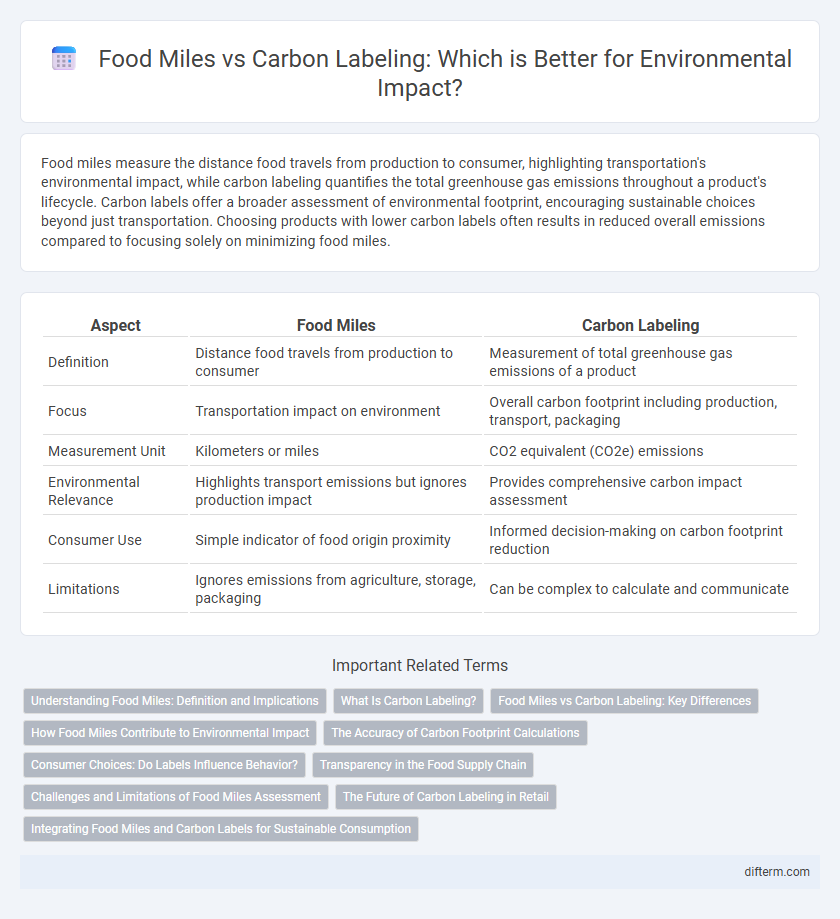Food miles measure the distance food travels from production to consumer, highlighting transportation's environmental impact, while carbon labeling quantifies the total greenhouse gas emissions throughout a product's lifecycle. Carbon labels offer a broader assessment of environmental footprint, encouraging sustainable choices beyond just transportation. Choosing products with lower carbon labels often results in reduced overall emissions compared to focusing solely on minimizing food miles.
Table of Comparison
| Aspect | Food Miles | Carbon Labeling |
|---|---|---|
| Definition | Distance food travels from production to consumer | Measurement of total greenhouse gas emissions of a product |
| Focus | Transportation impact on environment | Overall carbon footprint including production, transport, packaging |
| Measurement Unit | Kilometers or miles | CO2 equivalent (CO2e) emissions |
| Environmental Relevance | Highlights transport emissions but ignores production impact | Provides comprehensive carbon impact assessment |
| Consumer Use | Simple indicator of food origin proximity | Informed decision-making on carbon footprint reduction |
| Limitations | Ignores emissions from agriculture, storage, packaging | Can be complex to calculate and communicate |
Understanding Food Miles: Definition and Implications
Food miles quantify the distance food travels from production to consumption, directly influencing its carbon footprint by correlating longer transportation routes with higher greenhouse gas emissions. While carbon labeling provides a comprehensive assessment of a product's total emissions throughout its lifecycle, food miles offer a tangible measure to raise consumer awareness about transportation impact. Understanding food miles highlights the environmental implications of sourcing decisions and promotes local consumption to reduce carbon emissions linked to food transport.
What Is Carbon Labeling?
Carbon labeling quantifies and displays the greenhouse gas emissions associated with producing, transporting, and distributing a food product, providing consumers with transparent information on its environmental impact. Unlike food miles, which measure only the distance food travels from farm to consumer, carbon labels encompass the entire lifecycle emissions, including farming, processing, packaging, and transportation. This comprehensive assessment enables more accurate comparisons of the carbon footprint across different food items, guiding environmentally conscious purchasing decisions.
Food Miles vs Carbon Labeling: Key Differences
Food miles measure the distance food travels from production to consumption, primarily indicating transportation-related carbon emissions. Carbon labeling provides a comprehensive assessment of a product's total greenhouse gas emissions across its entire lifecycle, including production, processing, packaging, and transportation. Understanding the distinction between food miles and carbon labeling helps consumers make more informed choices by considering both transportation impacts and overall environmental footprints.
How Food Miles Contribute to Environmental Impact
Food miles significantly contribute to environmental impact by increasing greenhouse gas emissions through long-distance transportation of food products. Transport methods like trucks, ships, and planes rely heavily on fossil fuels, leading to elevated carbon footprints associated with imported or out-of-season produce. Understanding food miles' role allows consumers and policymakers to prioritize locally sourced food, thereby reducing overall carbon emissions and supporting more sustainable food systems.
The Accuracy of Carbon Footprint Calculations
Carbon footprint calculations often provide a more precise measurement of the environmental impact of food production by incorporating factors such as land use, fertilizer application, and transportation emissions. Food miles, which measure the distance food travels from production to consumer, can be misleading since they exclude key variables like production practices and supply chain efficiency. Accurate carbon labeling requires comprehensive lifecycle assessments to ensure consumers receive reliable data on the true environmental cost of their food choices.
Consumer Choices: Do Labels Influence Behavior?
Food miles provide a measure of the distance food travels from production to consumer, yet carbon labeling offers a more precise assessment of environmental impact by accounting for total greenhouse gas emissions. Studies indicate that carbon labels are more effective in influencing consumer behavior toward sustainable choices, as they communicate comprehensive climate costs rather than just transportation distance. Enhanced transparency through carbon labeling empowers consumers to prioritize low-impact products, thereby fostering environmentally conscious purchasing decisions.
Transparency in the Food Supply Chain
Food miles quantify the distance food travels, while carbon labeling measures the total greenhouse gas emissions throughout the supply chain, offering a more comprehensive environmental impact assessment. Transparency in the food supply chain is enhanced by detailed carbon labeling, enabling consumers to make informed choices based on the full carbon footprint rather than just transportation distance. Accurate carbon data encourages sustainable sourcing and reduces hidden environmental costs associated with production, processing, and distribution stages.
Challenges and Limitations of Food Miles Assessment
Food miles assessment often struggles with accurately reflecting the true environmental impact of food products because it overlooks factors like production methods, transportation modes, and supply chain efficiency. The carbon footprint of food is influenced more significantly by agricultural practices and energy use during processing than by distance alone. Misleading emphasis on distance can result in suboptimal consumer choices and ineffective sustainability policies.
The Future of Carbon Labeling in Retail
Carbon labeling in retail offers a transparent way for consumers to understand the environmental impact of their food choices, promoting more sustainable purchasing behaviors. While food miles measure the distance food travels, carbon labels provide a comprehensive assessment of greenhouse gas emissions throughout the entire supply chain. Advances in data analytics and blockchain technology are expected to enhance the accuracy and accessibility of carbon labels, driving greater accountability and green innovation in the food industry.
Integrating Food Miles and Carbon Labels for Sustainable Consumption
Integrating food miles and carbon labeling provides a comprehensive approach to promoting sustainable consumption by highlighting the environmental impact of both transportation distance and greenhouse gas emissions throughout the food supply chain. Combining these metrics enables consumers to make informed choices that reduce carbon footprints and support local, low-impact producers. Transparent labeling systems that incorporate food miles and carbon data drive demand for eco-friendly products and encourage industry shifts towards greener production and distribution practices.
food miles vs carbon labeling Infographic

 difterm.com
difterm.com